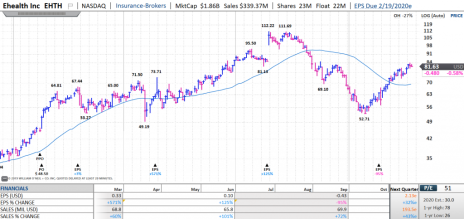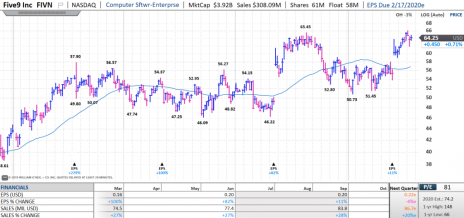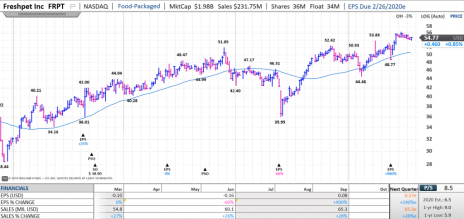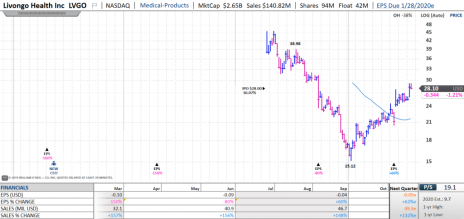In this Month’s Issue of Cabot Early Opportunities I reveal a few tips to help you buy into IPOs at reasonable prices and we look at some compelling data that suggests the 150 to 180 day period after IPO just might be one of the ideal times to buy.
We also go inside five companies that look great right now, including a few software stocks, a consumer goods company and a MedTech stock that’s flying under the radar now, but not for long!
Cabot Early Opportunities 103
Stocks in this Issue | Current Investing Environment |
IPO Strategy: When to Buy, and How to Handle Lockup Expiration
In most Issues of Cabot Early Opportunities, I cover stocks that have recently gone public. These early-stage stocks need to be handled with a little extra consideration because they are so new to the public markets and the stocks don’t have a lot of trading history.
Two of the biggest considerations are: (1) when to buy an IPO that you like given that the stock’s post-IPO trajectory is usually down, and (2) what to do about the lockup expiration date. Do you buy before, on, or after?
Let’s tackle the first consideration first. After the IPO event there is often a period I refer to as the post-IPO blues. This is when the excitement of the IPO roadshow and big event have passed, and a stock settles into real life as a public company. In general, this happens at some point in the first four months of trading, and after the initial IPO surge (which usually happens on day one). The stock then trends down, often landing well below its IPO price.
This pattern (which happens often, but not always) scares a lot of would-be investors away because, why buy a hot new stock if it’s going down every day? Where’s all the investor demand?
This pattern happens over and over because it takes several quarters for everyone to understand the ebbs and flows of revenue and earnings, get comfortable with the company’s business model and cozy up to management’s communication style. There is a relationship to build between stock and public investors. And that just takes time.
How long? Usually, at least six months (180 days). But often more. And only afterward will the newly public stock begin to settle into a trading pattern that we can begin to understand.
Not coincidentally, another major event happens around that six-month/180-day milestone. That’s lockup expiration. When a company goes public insiders (founders, employees, management, VC firms, etc.) are prohibited from selling shares. The restriction is usually 180 days, and is intended to protect IPO investors from intense selling pressure right after they’ve jumped in.
The lockup expiration day is when these insiders are free to sell. And they often do. Which, rationally, seems concerning to many investors. Why buy a stock if people on the inside with a lot more knowledge are selling?
Don’t worry about it. Insider selling happens for a lot of reasons. One of the main ones is that insiders, just like the rest of us, want to diversify their holdings. The IPO is a liquidity event that helps them realize the paper profits they’ve built up over the years. It’s totally understandable that a founder, early investor, or loyal employee would want to book a profit and free up some cash to do whatever the heck they want with it.
In other words, insider selling is not always an indication that these people think the company is going to hell. They usually just want to do what any one of us would – cash out some of their position and not have their financial future so heavily reliant on what happens to one company.But what about buying in the months before these insiders are going to start selling some (usually not all) of their shares? Is that a dumb move?
No, it’s not.
Recent data from JP Morgan shows that the fear of lockup expiration is far worse than the actual event. Why? Because it’s a known event, so investors can strategize around it.
JP Morgan analyzed 21 IPOs dating back to March 2018 and found that the stocks were down an average of 10% in the 30 days before lockup expiration (i.e. in the period of 150 to 180 days after IPO) but then were up in the one-, five- and 30-day periods after lockup, with average gains of 0.4%, 2.2% and 8.3%, respectively.
Notably, 16 of the 21 stocks (76%) were down in the month before lockup, while only five (24%) were down in the five-day period after, and only five (24%) were down in the 30-day period after.
As always there are caveats to pure data analysis. Still, this data offers compelling evidence that when looking specifically at lockup expiration, investors shouldn’t be overly concerned about a flood of shares hitting the market and crushing the stock.
In fact, the opposite is seen to be more accurate – shares of IPOs tend to rise at, and soon after, the lockup expiration date. That implies buying in the 30-day period ahead of the event (150 to 180 days after IPO) could be a wise move.
Stepping back, my advice is to think about buying newly public stocks as a process rather than a point in time. Average into the stock in several purchases (three to four, at least) over time (30 to 60 days, at least) to spread out your cost basis. Specifically, look to make at least one purchase when the “post-IPO blues” have settled in, and another in the 30-day period leading up to lockup expiration.
This isn’t going to work perfectly for every single IPO out there as there are always outliers that shoot straight up, and those that fall apart and never recover. But following these general guidelines and adjusting to the specific situation as an IPO matures should lead to better IPO investing success.
What to Do Now
With growth stocks acting strong and steadily recovering from October lows it’s a good time to be picking up early-stage growth stocks. Keep averaging in but recognize that after several weeks of strong performance many leading stocks could easily give back some of their recent gains.
Should a modest retreat occur the dip would likely represent another buying opportunity. That’s because the big picture is looking better for stocks due to improving sentiment on the major known risks out there (i.e. lower interest rates, rising confidence in sustained economic growth, lower risk of recession, modest optimism on trade, etc.).
All the stocks in this Issue have posted relatively strong performance in recent weeks. Three of them are within striking distance of all-time highs, including contact center specialist Five9 (FIVN), pet food innovator Freshpet (FRPT) and revenue management software specialist ModelN (MODN).
The other two, online health insurance broker eHealth (EHTH) and diabetes specialist, recent IPO and this month’s Top Pick Livongo (LVGO), are well off highs, but recovering nicely and in sustained uptrends. All are squarely in the small-cap asset class, with market caps ranging from $1 billion to $4 billion.
STOCKS
eHealth (EHTH)
The genesis for eHealth was a young man named Vip Patel lying in his bed in the mid-1980s with little money, no health insurance, a bad case of food poisoning and no clue what to do. In 1998 (he had recovered by then!) Mr. Patel jumped on the dot-com bandwagon and created eHealthInsurance.com to serve as an online resource where consumers could research, analyze, compare and purchase health insurance products. His company sold the first online insurance policy, and went public in 2006.
Today, eHealth has a market cap of $1.9 billion and operates as a health insurance broker and online comparison site geared to individuals, families and small businesses (18% of revenue in Q3 2019), and Medicare enrollees (82% of revenue in Q3 2019). It is licensed in all 50 states and generates 90% of revenue through commissions.
With a modern, cloud-based software platform that offers omni-channel shopping, broad plan selection (over 170 carrier partnerships), modern comparison tools, an enjoyable digital experience (net promoter score of 91) and agent support, eHealth is well-positioned to keep growing quickly.
The trends in the Medicare market are particularly strong. Industry analysts see the number of Medicare Advantage and Medicare Supplement enrollees climbing by 56% to 50 million between 2016 and 2026. Yet data suggests only one in 10 Medicare beneficiaries enroll in the best plan. That means a big opportunity for eHealth to continue to serve this community better.
The company’s strategies appear to be working. In 2018 it grew Medicare membership by 26%, seven times faster than the 3.5% growth rate of total Medicare enrollments. It now has 521,000 Medicare members, which still represents less than 1% of the addressable $19 billion Medicare market. In Q3 2019 eHealth grew revenue by 75% in its Medicare business.
At the same time the company’s individual, family and small business segment is putting up impressive numbers. Revenue in this segment was up 59% in Q3 2019. All in, total Q3 revenue was up 72% to $69.9 million.
Analysts see revenue of $400 million this year (up 60%) and a huge jump in adjusted EPS, up 122% to $2.24. In 2020, consensus estimates point toward 25% revenue growth and 22% EPS growth.
The Stock
EHTH’s stock was a non-story for most of the last decade. That is, until mid-2018 when the company started growing again and shares took off. Shares broke out to multi-year highs above 23 in August 2018, then ran up into the mid-60s in January. EHTH took off again in the spring, ran to 112, then corrected along with many other growth stocks in August and September. The bottom formed just above 52 in mid-October and EHTH has been chugging steadily higher since.
Five9 (FIVN)
With the explosive growth of e-commerce, mobile apps and social media, companies across the size spectrum and industry landscape have finally realized it is less expensive to keep current customers happy than it is to acquire new ones. Customers have many choices these days, and there are virtually no barriers to leaving negative online reviews and social media posts.
Yet, despite spending over $230 billion a year on contact centers, many organizations are still falling well short of the mark in the customer service department.
One of the best ways to improve is to implement easy-to-use apps that manage and optimize customer interactions across voice, chat, email, web, social media and mobile channels. This is what Five9’s (FIVN) founders set out to do back in 2001. Since going public in 2014 the company has risen to the top of the cloud-based contact center market for two big-picture reasons.
First, Five9 has developed an innovative cloud-based call center platform that’s taking advantage of the shift from on-premise call centers to SaaS based solutions. And second, it arguably has the best platform in the business, powered with big data and artificial intelligence (AI) technologies, and featuring deep integrations with Microsoft Teams, Google, Salesforce.com and more.
Five9 is slashing wait times and empowering organizations to make their customers feel like people, not numbers. And its mission to transform contact centers into customer engagement centers of excellence is clearly resonating with the market, especially among larger enterprise customers.
Revenue was up 30% in 2018 and is on pace to rise 23%, to $320 million, in 2019. In Q3 2019 (just reported November 5) revenue rose 28%, driven by strength in the Enterprise business (up 36%). EPS of $0.20 was up 11%. Consensus estimates are calling for 2020 revenue to be up 16%, to $370 million, while EPS should jump 10%, to $0.86. I expect Five9 will surpass expectations, as has been the trend for some time.
The Stock
FIVN went public in 2014 at 7 and was cut in half before it finally recovered and began to take off in late 2015. From there the stock’s weekly charts shows a series of higher highs and higher lows with normal-looking consolidation phases and the occasional pullback to the 50-day line. On the daily chart the latest consolidation phase, in the 46 to 57 range, persisted from February through July. FIVN then broke out and ran to 65, pulled back to 50, and is now pushing up near all-time highs once again.
Freshpet (FRPT)
Freshpet is a $1.9 billion market cap company that sells pet food for dogs and cats using fresh, whole ingredients that are gently cooked without preservatives. In this context “fresh” means refrigerated, and therein lies one of the distinguishing charactersistics of this company: Freshpet owns 20,000 of its own fridges.
This gives it a competitive advanatage because most food retailers don’t want to manage a second group of fridges just for dog food. Freshpet has taken that responsibilitiy off their shoulders. And that’s making it harder for competitors to gain a foothold in the industry. Freshpet is currently the biggest producer of fresh dog food in the United States. However, there are specialty companies gaining traction online, so Freshpet is clearly not the only player out there.
Most of the company’s revenue ($190 million in 2018, up 19%) comes from dog food sold in bag and roll formats. It’s been growing consistently since it was founded in 2006, and by over 70% in the last three years, because of its unique business model (company-owned fridges), rising pet ownership (70% of U.S households) and steadily increasing price-per-pound for pet food (up almost 50% since 2011). This puts the company at the top of the growth stack in the consumer goods industry where double-digit growth is hard to come by. Undoubtedly, Freshpet’s growth profile also makes it an attractive aquistion target, though it’s doing just fine on its own!
Analysts are generally positive on the stock, though many are admittedlly not sure where the company’s growth rate will go in the futue. Some see a deceleration to mid-single-digit growth a decade from now. But that’s honestly too far away to be of much concern. Freshpet could easily be acquired by then, or rolling up smaller players with an acquistion-led growth strategy that could sustain double-digit growth. We’ll just have to see.
In the meantime, consensus estimates point toward revenue growing 32% in 2019 (to $250 million) and management delivering the first year of adjusted profitability (estimated EPS of $0.02). In 2020, analysts see revenue up 20%, to $300 million, and EPS soaring to $0.58.
The Stock
FRPT went public in 2014 at 15 and suffered the typical IPO blues soon after. Shares eventually bottomed near 6 in early 2016 and began to grind higher, eventually breaking above their post-IPO high of 24 in June 2018. Shares ran to 40 last October, pulled back into the end of 2018, then advanced steadily to 52 in June. Another wobble last summer cut FRPT back to 36. But this latest advance has the stock trading near all-time highs once again.
Livongo (LVGO)
Livongo is a $2.4 billion market cap company that specializes in Type 2 diabetes digital health management. This market affects roughly 28 million Americans and is estimated at well over $6 billion today ($8 billion, including Humana and UnitedHealth). Livongo’s unique platform also positions it well to compete effectively in the adjacent hypertension market, which is estimated at $4 billion. Expansion into weight management and behavioral health markets represent emerging opportunities as well.
Livongo just went public in July 2019. It is growing rapidly as the first mover with a subscription-based software platform for diabetes that’s targeted at employers (>1,000 employees), Medicare Advantage and commercial insurance payers. This platform integrates data science and behavioral insight technology with blood glucose finger sticks, an established care method, to create a holistic and digitized care experience centered on consumers with chronic conditions.
The end goal is to improve care and lower costs, which is why clients are jumping on board, both for diabetes and for new products. Near-term growth will be driven mainly by new client adds, especially those with over 5,000 employees. Partnerships with channel partners (top five are CVS, Express Scripts, Anthem, Highmark and HCSC), which drive roughly 50% of revenue, should help too.
One recent win was with the Federal Employees Health Benefits Program (FEHBP), covering both Type 1 and Type 2 diabetes for over 45,000 members by 2021. This contract is valued at up to $25 million in 2020 and up to $35 million in 2021.
While there are many other players in the diabetes management market, including glucometer manufacturers (Abbott, J&J, Bayer, Roche), glucose monitoring companies (DexCom), and large tech players making inroads into digital health markets (Google, Apple), Livongo stands out because it is the only one with a full range of services – spanning analytics to coaching – that fully address the care continuum for Type 2 diabetes patients.
Revenue soared 128% in 2018 and is seen up another 148%, to $170 million, in 2019. In 2020 analysts see revenue up 68%, to $180 million. Livongo is not yet profitable and is expected to deliver an adjusted EPS loss of -$0.53 in 2019 and -$0.26 in 2020. It should be profitable in 2021.
The Stock
LVGO just went public in July at 28 and soared 36% on its first day of trading. The fun ended there, as shares retreated almost daily until they bottomed near 15 on October 1. The road higher has been as swift and steady as the trip down. LVGO has been inching higher almost daily, with a nice gap up above 24 after Q3 earnings came out, and a jump above 27 on Tuesday this week.
Model N (MODN)
Model N has been serving the life science and technology industries with revenue management software since it was founded in 1999. But depite a 20-year operating history the company is early-stage in my view because of a refreshed management team and an ongoing transition from on-premise software to a cloud-based subscription business model. Coupled with new senior management hires and a reshuffling of the sales, Model N looks prepped to succeed in the age of the SaaS business model and surpass expectations for many quarters to come.
So what exactly does the company do? It helps customers maximize their revenue, drive growth, and cut compliance risk by giving them software tools to manage the revenue lifecycle as a strategic process, not the disjointed one that all too often plagues the big players in its target markets. This means cloud-based software that covers pricing, quoting, contracting, regulatory compliance, rebates and incentives.
Model N’s customers, which include big brands across pharma, medical device, technology, manufacturng and semi, use these solutions to simplify their complex businesses. The roster of current customers is impressive, including J&J, Pfizer, Gilead, Abbott, Stryker, AMD, Seagate, Sonos, STMicorelectronics, AstraZeneca and Sanofi.
The company’s historical growth rate is a little inconsistent because of the recent transition from the on-premise to the SaaS business model. Revenue was up 23% in 2018, when Model N delivered adjusted EPS of $0.04. In fiscal 2019, which ended on September 30, revenue declined by 12%, but EPS jumped 450%, to $0.22.
Looking forward things should be more consistent with revenue set to climb 7%, to $150 million, in fiscal 2020 then another 13% in fiscal 2021. Adjusted EPS shold be up 27%, to $0.28, in 2020, then up 32% to $0.37 in 2021.
The Stock
MODN was a challenged stock in the early years as a public company. For most of the time between its 2013 IPO (at 15.5) and the end of 2017 MODN traded well below its IPO price. A convincing rally took shares as high as 20 in August 2018, but a nearly 40% retreat broke up the party. The breakout above 20 came this past July, then a massive gap up to all-time highs above 23 happened in August after a big Q3 earnings report. MODN then consolidated in the 26 to 30 range, but shares are above 30 now and looking strong.
Previously Recommended Stocks
Below you’ll find previously recommended Cabot Early Opportunities stocks. Stocks rated BUY are suitable for purchasing now. In all cases, and especially IPOs, I suggest averaging into every stock to spread out your cost basis.
Those rated HOLD are stocks that still look good and are recommended to be kept in a long-term oriented portfolio. Or they’ve pulled back a little and are under consideration for being dropped.
Stocks rated DROPPED didn’t pan out, or the uptrend has run its course for the time being. They should be sold if you own them. DROPPED stocks are listed in one monthly Issue, then they fall off the DROPPED list and into oblivion.
Please use this list to keep up with my latest thinking, and don’t hesitate to call or email with any questions. In terms of stock updates, I typically cover those in Special Bulletins.
Our top performers are Deciphera Pharmaceuticals (DCPH), which was featured in October and is up 39%, Digital Turbine (APPS), September’s Top Pick and up 24%, and Dynatrace (DT), a recent IPO featured in September that’s up 9%.
Detractors from performance are The RealReal (REAL), featured in October, down 19% and recently moved to HOLD, Frontdoor (FTDR), featured in October and down 11%, but recovering, and Arco Platform (ARCE), featured in September and down 9%.
Finally, TheRealReal moves to DROPPED due to poor performance. And Kornit Digital (KRNT) gets bumped down to HOLD because of lackluster performance in the days after reporting Q3 results on Monday, November 18.
The next Cabot Early Opportunities issue will be published on December 18, 2019.
Cabot Wealth Network
Publishing independent investment advice since 1970.
CEO & Chief Investment Strategist: Timothy Lutts
President & Publisher: Ed Coburn
176 North Street, PO Box 2049, Salem, MA 01970 USA
800-326-8826 | support@cabotwealth.com | CabotWealth.com
Copyright © 2019. All rights reserved. Copying or electronic transmission of this information is a violation of copyright law. For the protection of our subscribers, copyright violations will result in immediate termination of all subscriptions without refund. No Conflicts: Cabot Wealth Network exists to serve you, our readers. We derive 100% of our revenue, or close to it, from selling subscriptions to its publications. Neither Cabot Wealth Network nor our employees are compensated in any way by the companies whose stocks we recommend or providers of associated financial services. Disclaimer: Sources of information are believed to be reliable but they are not guaranteed to be complete or error-free. Recommendations, opinions or suggestions are given with the understanding that subscribers acting on information assume all risks involved. Buy/Sell Recommendations: All recommendations are made in regular issues or email alerts or updates and posted on the private subscriber web page.









